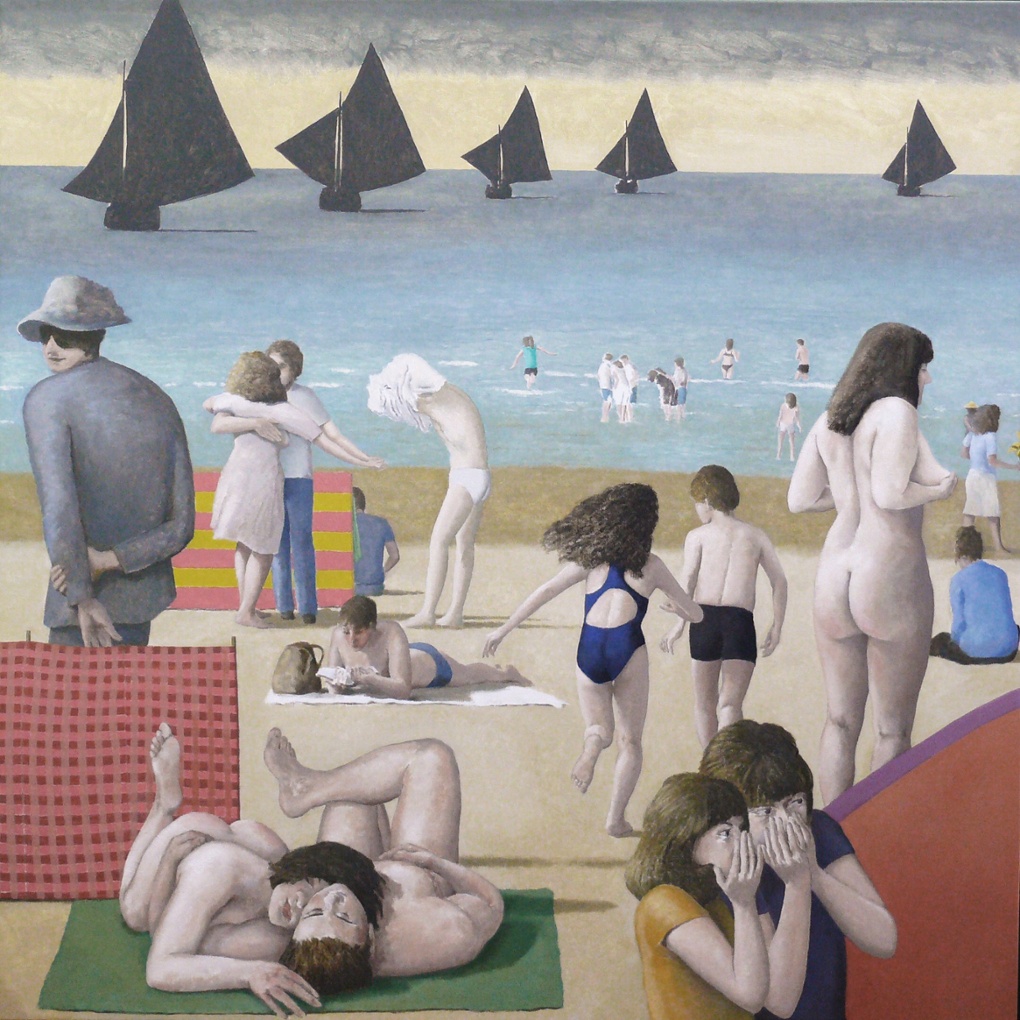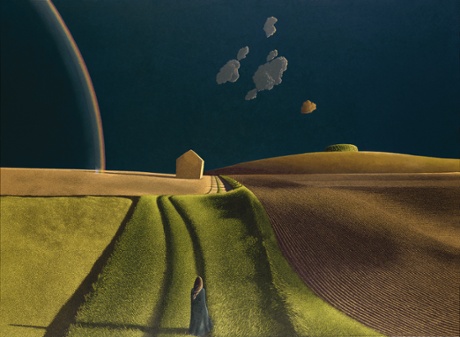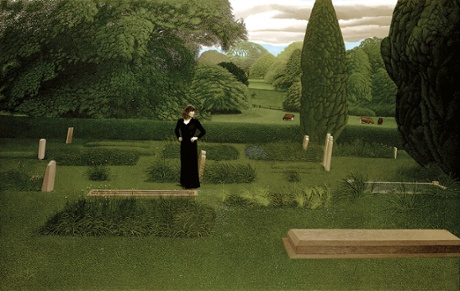
Andrew Lambirth, The Guardian, October 02, 2015
At the age of 72, the painter David Inshaw is finally beginning to achieve the kind of widespread recognition he deserves. He is a great pastoral painter and visionary, that rare kind of artist who appears perhaps once or twice in a generation and illumines the world in a new way – for those who are prepared to look. William Blake, Samuel Palmer, Paul Nash and Stanley Spencer are among his progenitors. Inshaw paints the landscape and the figure with imaginative intensity, and his pictures are rich with personal memories and associations.
William Blake stated that “No Man of Sense ever supposes that copying from Nature is the Art of Painting”. Although Inshaw’s art is based on observation of the real world, he brings to it a highly personal interpretation. Private experience is rendered timeless and universal by conjuring the particular character of the English landscape through a combination of many observed moments, distilled and translated into a new unity. Individual and environment are matched and mutually fulfilled in terms of formal ideas (the shapes and colours of things) and human meaning.
The challenge facing any realist painter in the 21st century is how to depict the world around us with memorable originality. Somehow an artist has to make us see the world anew and discover in it a resonance applicable to our era and condition. Inshaw has done this by investing his imagery with the sense of wonder he feels in the West Country landscape, coupled with an instinctive understanding of the deep contradictory currents of the human heart. His paintings are so compelling because he is not afraid to paint beauty and mystery with a ringing clarity that goes to the head like champagne.

Allegory (2014-15) by David Inshaw
In the autumn of 1971 he moved to Devizes in Wiltshire, and aside from a brief sojourn in Wales, has remained there ever since. He got to know the Vale of Pewsey and the Marlborough Downs from visits to Stonehenge and Avebury, prehistoric sites that drew him by their ancient authority and presence. Although they were actual places with historical traditions and meanings, they were also sites of myth and magic, and it is no coincidence that Silbury Hill (the less obvious adjunct to the standing stones of Avebury) has become a favourite subject for Inshaw. He has recalled: “I fell in love with the Downs and the Vale on my first visit. I felt as if history had been condensed to a moment … The symbols and evidence of man, distant past all around me, gave me reassurance and confidence to develop the ideas that had just begun in me over the previous two years.”
Inshaw loves painting strikingly curvaceous nudes of dauntless sensuality, but his landscapes are always more popular, and as an artist who lives by his brush, he has to consider his market. Occasionally he will produce a more complex painting of several interactive figures, perhaps allegorical in intent, and often frankly mysterious. The most famous of these is The Badminton Game, painted in 1972-3 and acquired by the Tate Gallery in 1980, one of the most enduringly popular images in the museum’s collection.
Although Inshaw is often thought of as a landscape painter, his paintings of town gardens offer a new blend of urban and rural, using buildings and the trappings of cultivation to accentuate, frame and contextualise the human emotions of his dramas. Photographs are a useful research tool, but he is also a distinguished draughtsman who can project the fire of his vision through the point of a pencil almost as movingly as through oil paint. “I think my main aim was to produce a picture that held a moment in time,” he wrote, describing The Badminton Game, “but unlike a photograph, which only records an event. I thought a painting could give a more universal deeper meaning to that moment, by composing one instant from a lot of different unrelated moments.” And he explained: “For some time I had thought of painting as a way of bringing order to the chaos I saw about me and felt inside me. The more chaos I felt, the more order I desired in the pictures I made.”

She Did Not Turn (1974) by David Inshaw
Actually, he was in a bit of a muddle, having fallen in love with both the women who modelled for the painting, and he filled the picture with the bright sunlight (and shadows) of his passion. The clear, early morning air anoints the women in their Biba dresses, but there is also a sense of foreboding. The trees loom up with vigorous masculine symbolism, adding a touch of uncontrollable wildness to the clipped garden hedges and bushes. But generally this is a hopeful image, and only slightly disquieting. The painting is almost a statement of Inshaw’s response to the spirit of place, as Wiltshire began to exert its enchantment on him.
I have dwelt on this painting at some length not just because it is an early and particularly engaging masterpiece, but because it explains so much about the artist’s methods. He tried to define the picture’s essence thus: “It is the moment held in time, as if you are aware of before and after, as if a film had stopped on a single frame, and you are aware, in that instant, of the emotion of all time. This is very difficult to explain. It’s what I still try to do now, because I think it is everything in painting pictures, and I look for it always. To isolate in time and space things that would normally disappear under the awful impact of other values. I wanted to pin down a moment, make it go on living.”
Inshaw sees his primary task as drawing our attention to things that are worth thinking about. Once engaged, viewers are invited to make their own story from his hinted-at narrative. Among his new paintings which encourage such a response is Fire Eater, depicting a lonely figure in profile blowing a plume of flame into the night sky, with a young girl doing a handstand in the foreground, while a huge thrush wings overhead and a much smaller helicopter enters from the right. The subject could refer to Inshaw’s old friend Karl Weschke (1925-2005), who painted his own fire-eater 30 years ago, or it might reference Hardy’s poem “The Darkling Thrush”, but essentially it is a stirring conjunction of discrete images demanding interpretation.

Our Days Were a Joy and Our Paths Through Flowers (1971-72) by David Inshaw
Allegory I and Allegory II are multi-figure beach scenes which unite close observation from life with quotations from the Old Masters, such as Piero della Francesca, Uccello, Bosch and Bruegel. For instance, the little harlequin figure in Allegory II comes from Bruegel’s Fight Between Carnival and Lent, and is one of Inshaw’s favourite characters in art. But there’s a sinister aspect to this costumed creature carrying a torch or a weapon. In fact, it is disturbingly reminiscent of the red-coated dwarf murderer in Nicolas Roeg’s film Don’t Look Now. The strange black boats in Allegory I, sailing away from shore, could refer to the famous saturated black sails in Turner’s painting Peace – Burial at Sea; equally they could indicate the marauding presence of pirates. Or they might remind us of classical Aegeus heartbroken at the sight of Theseus’s black sails. But the real point is that they hold our attention and make us wonder. Thus we are involved, and start to participate in the painted drama.
Inshaw is not a speedy painter, but reworks and refines an image until he’s entirely satisfied with it. This long meditative process has given rise to a substantial catalogue of pictures notable for their lyrical poignancy and affectionate warmth. The roster of Inshaw subjects includes May trees incandescent with blossom, the cliffs at West Bay, Bridport in various moods and weathers, cricket, lighthouses, oak trees, fireworks and bonfires, birds, cats and fish, lightning bolts, tents and meadows, and always women, mostly unclothed. He is a master of the pastoral erotic, of sexy figures frolicking in the landscape. Inshaw’s paintings crackle with the energy of renewal, of the past inflecting the present, of dream augmenting reality, of wonder outweighing despair. His richly varied art, the product of much thought and prolonged looking, is quite simply life‑enhancing.
• Andrew Lambirth’s David Inshaw is published by Unicorn Press. To order a copy for £30, go to bookshop.theguardian.com or call 0330 333 6846. Free UK p&p over £10, online orders only. Phone orders min. p&p of £1.99.
This article originally appeared on guardian.co.uk
This article was written by Andrew Lambirth from The Guardian and was legally licensed through the NewsCred publisher network.
![]()